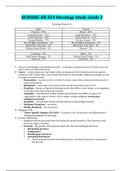Study guide
NURSING NR 324 Oncology Study Guide 2 Complete Graded A
- Course
- NR 324
- Institution
- Chamberlain College Of Nursing
NURSING NR 324 Oncology Study Guide 2 Oncology Chapter 16 Male Female Prostate – 29% Breast – 26% Lung/Bronchus – 15% Lung/Bronchus – 15% Colon/Rectum – 10% Colon/Rectum – 11% Urinary Bladder – 7% Uterine Corpus – 6% Non-Hodgkin Lymphoma – 4% Non-Hodgkin Lymphoma – 4% Melanoma o...
[Show more]



